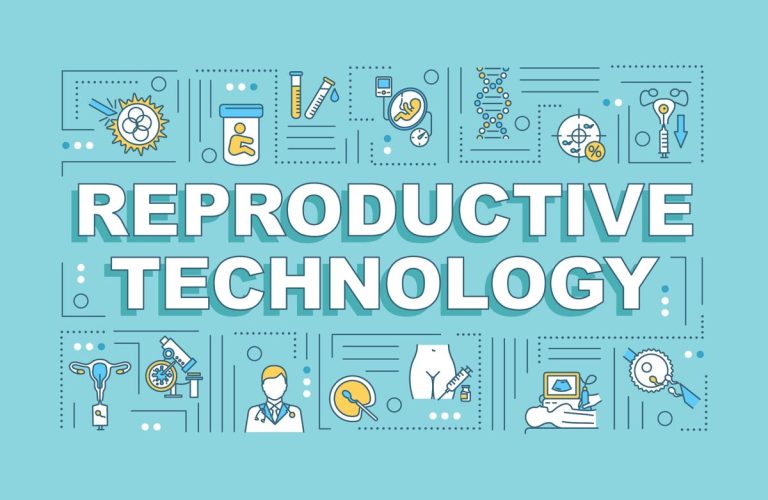Introduction
Who you name as beneficiary is obviously fundamental to carrying out your dispositive wishes. How your legal documents (will, revocable trusts, irrevocable trusts, beneficiary designations) use words like “child,” “descendant,” and “issue,” is critical to assure that the people you want included are included, and those you may not wish included are not. How modern medical reproductive techniques, social mores, adoption, out of wedlock children, and other considerations should be addressed are complex and evolving considerations. This article will explore some of them and the possible implications for your estate plan.
Reproductive Technologies
Assisted Reproductive Technologies (“ART”) are modern medical procedures typically used to treat low fertility or infertile couples. ART includes treatments in which eggs or embryos are surgically removed from a woman and then combining them with sperm in the laboratory, and thereafter implanting them back in the donor woman, or donating them to another woman to carry the baby.
These techniques have also been used by non-traditional families to conceive children. Modern reproductive technologies have had a tremendous impact on many seeking to have children. These developments have also created new complications and issues for estate planning. And this may be just the beginning. How might future medical developments further transform this new and already complex field? How will future reproductive technologies impact the determination of who is an heir and who will inherit under which documents? The philosophical, moral and religious implications of these techniques are also significant, but beyond the scope of this article.
From an estate planning perspective, should the people born of these techniques be characterized as children and of which persons? Is it the person donating genetic material to the parent? Or is it the surrogate who carried the fertilized egg to the parent? Who? The answer is complex and will depend on the intent of those involved, contractual agreements that may have been signed, state law, the terms of wills and trusts, and other factors.
Assisted Reproductive Technology Techniques and Terminology
These techniques might include, and some of the terminology of ART include the following:
· Artificial insemination is the injection of semen into a female’s vagina or cervix and may be used, for example, when a couple suffers from infertility for reasons that cannot be identified. It is also used in same-sex partnerships who wish to have a child. Semen could be obtained from the male/husband, from a different male donor (e.g., for a lesbian couple or if the husband is sterile), from storage in a sperm bank. Questions that may arise from these procedures is what parental rights, if any does the sperm donor have. The corollary to that is what rights will that child have to inherit, if any, from the male sperm donor. Another issue that arises is if the insemination is completed after the sperm donor died, how might that affect the child’s rights to inherit.
· In-vitro fertilization (“IVF”) is a procedure used to help a couple wishing to have a child that is struggling with fertility issues, or by a same-sex couple seeking to have a child, or to endeavor to avoid genetic issues. The technique involves harvesting mature eggs from a female’s ovaries and fertilization outside the body. This could be from the wife of the couple, or if she is infertile a third party donor, or a third party for a same sex couple. Those eggs are then fertilized by sperm in a laboratory. The eggs (or embryos) and the sperm may be donated by a known or anonymous donor. In addition to the issues noted for artificial insemination with IVF what parental rights the egg donor may have may be a question. What rights the child may have to inherit from the egg donor is the corollary to that.
· Gestational carrier is a woman who has a fertilized egg implanted in her uterus. The man seeking to be the father and the woman seeking to be the mother may provide the sperm and egg, respectively. Alternatively, a third party donor may be used for one or both of the egg and sperm. The carrier is generally not genetically related to the intended parents or child. The gestational carrier does not use her own egg in the process (see surrogate below). What parental rights might the gestational carrier have to the child, if any? The corollary to that is what rights, if any, does the child have to the gestational carrier?
· Surrogate is a gestational carrier who uses her own eggs as opposed to the eggs of another donor, (such as an egg of the intended mother). The questions of what parental rights the surrogate may have to the child, and what rights, if any, does the child have to the surrogate may be more nettlesome than for a mere gestational carrier since it is the surrogate’s own egg that resulted in the baby.
· Gametes are reproductive cells that only contain half of the genetic material required. When fertilization occurs, male and female gametes join creating a zygote. Donors may donate gametes, sperm or egg, to a bank or a person seeking to have a child. The legal arrangement and documentation of that process may affect the parental rights of the donor, if any, and of the resulting child to that donor, if any.
Concepts Potentially Involved in ART
The above has created three concepts in determining the rights of the donor and of the child. In any particular situation these may occur individually or in some combination:
1. Genetic parentage resulting from the contribution of gametes, either egg or sperm to the birth of a child.
2. Gestational parentage resulting from the carrying of the child through birth.
3. Functional parentage resulting from the carrying for and raising of the child.
Uniform Parentage Act (“UPA”)
The UPA endeavors to provide a uniform legal framework for determining paternity of minor children. This may affect children born to married couples or unmarried couples. The UPA may permit more than two people to be legally recognized as parents of a particular child. If a man donates sperm that is used in the birth of a child, whether or not that man would have rights as a parent will depend on the intent he had to be a parent or not at the time of the donation.
The UPA has been revised several times since it was first introduced. The states that have enacted the UPA have made some changes to the standard provisions of the act. Thus, state laws still vary considerably on these matters and anyone seeking clarity should have an attorney determine which state law applies, and then that for which that state law provides.
Post-Humous Conception
Traditional or historic post-humous conception may have been simple compared to modern scenarios.
Example: A married couple conceived a child before the death of the husband. Husband then died and thereafter the child was born. Since the child was conceived during the marriage and the husband was aware (or presumed to be aware) of his wife’s pregnancy during his lifetime, the child born after his death would be deemed his child for inheritance purposes. A similar scenario would occur if the mother were, for example, in a car accident in which she did not survive and the fetus was rescued.
The advances in ART have permitted conception to occur after the person donating genetic tissue has died, hence the term “post-humous” conception. This can occur under several circumstances and hence raise a variety of legal issues. Consider the following examples.
Example: A male is diagnosed with cancer and before treatments begin freezes sperm for future use with his wife in the event that the cancer treatments render him sterile. He later dies and following his death his wife uses the frozen sperm to fertilize and egg and carry a baby as they had both wished.
Example: A male dies, or is incapacitated, and his sperm are harvested without his having given consent during his lifetime or when he had legal capacity to do so. Following his death his wife uses the frozen sperm to fertilize and egg and carry a baby as she indicated that they had both wished.
Example: A male is injured and rendered legally incompetent. He is the scion of a wealthy family and the beneficiary of a very large trust. The trust provides that on his death the assets of the trust will pass to his issue, and if no issue to charity. His wife has his sperm harvested without his having given consent when he had legal capacity to do so. Prior to his death his wife uses the frozen sperm to fertilize and egg and carry a baby for the sole purpose of creating a descendant who can benefit from the large trust fund above. Her hope is that this will enable her to indirectly benefit through the child being born.
Example: A male donated sperm which is frozen. He then dies. Some years later his wife learns that her late husband might be an heir to a large trust fund. Some five years after his passing, his wife has undergone IVF to have his sperm fertilized and egg and carry a baby for the sole purpose of creating a descendant who can benefit from the large trust fund above. Her hope is that this will enable her to indirectly benefit through the child being born.
These examples raise many issues. Is it appropriate or even legal to harvest genetic material if someone has not consented? What is required to support “consent” to such actions? How long after death might someone whose consent wasn’t specific agree to have had their genetic material used? What are the legal implications to whether or not the resulting child should be deemed a descendant of the person contributing genetic material while alive?
Similar examples could be created for the harvesting of genetic material from a female for transplant after fertilization into a gestational surrogate.
Non-Marital Child
Historically, a child born out of wedlock might not have been inherited from either parent. Now, however, a non-marital child may be presumed to be a descendant who can inherit, unless the will or trust expresses a clear intent otherwise. DNA testing might be used to confirm or establish parentage. The father may expressly in writing acknowledge that the child should be treated as his. Some state laws base inheritance rights on whether or not the purported father functioned as a parent to the child. There could be considerable differences in what that phrase may mean. This all could be uncertain, so certainly if feasible it is preferable to address the matter with specificity in the will and trust or even more so, adopt the child if there is uncertainty and that is an option.
Adopted Child
State law may treat an adopted child no differently than a biological child for inheritance purposes. However, older trust documents may expressly exclude an adopted child so care should be exercised.
What Might Estate Planning Documents Address?
Should wills and trusts address whether a child born from genetic material be considered a valid heir? Should they address or differentiate whether the person donating the genetic material consented in writing to the use of their genetic material in a particular manner? Should there be a time limit that the child should be in gestation before death? Should there be a time limit that the child should be in gestation or born within some maximum number of months or years following death? If so, how long? How will such provisions, if addressed, be affected by the terms of agreements with the donor bank holding the genetic materials? Should there be a requirement that a person function as a parent to be treated as a parent of a child?
Should health care proxies provide a provision forbidding (or perhaps permitting, or even encouraging, depending on your wishes) an agent to have genetic material harvested and frozen? Should health related documents authorize an agent to expressly execute an agreement with a cryopreservation firm? Should the agent under the financial power of attorney be authorized, or perhaps directed, to pay for such services as selected in the decision of the health care agent?
In addition to traditional estate planning documents such as a power of attorney, health proxy, will and trust, contractual documents with a surrogate, storage facility, etc., may be important to determining the legal status of a child as well as inheritance rights for that child. The contracts entered into with a surrogate should clearly indicate whether the surrogate has any parental rights and whether the child would have any inheritance rights from the surrogate. Agreements with storage facilities should indicate who has the right to determine the use and disposition of genetic material. For example, should the spouse of the donor have that right? Should there be limits?
Read the full article here









